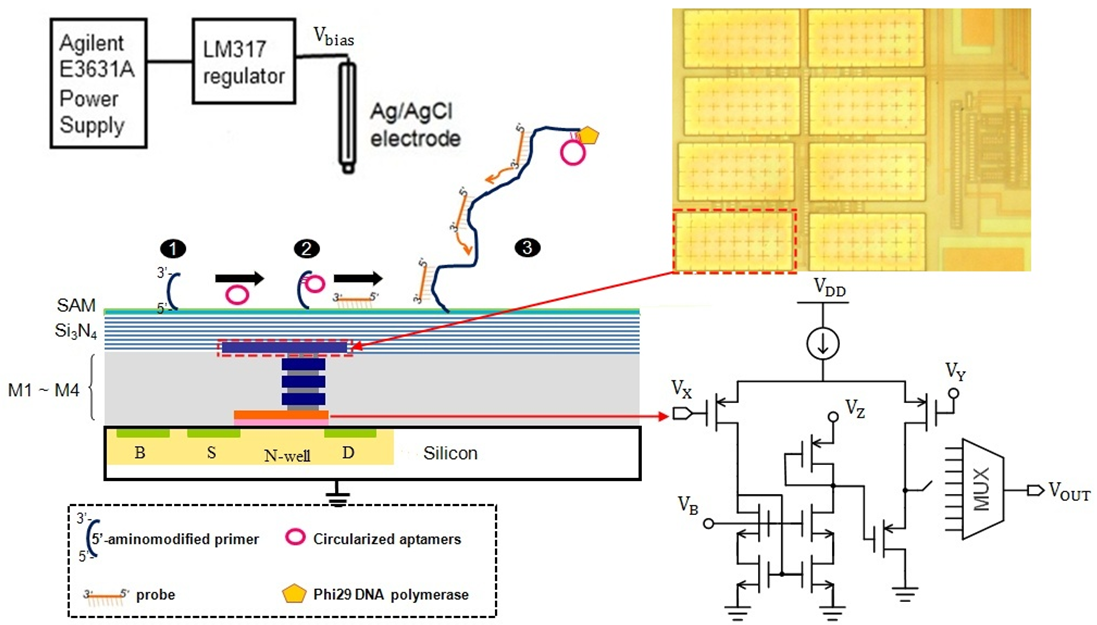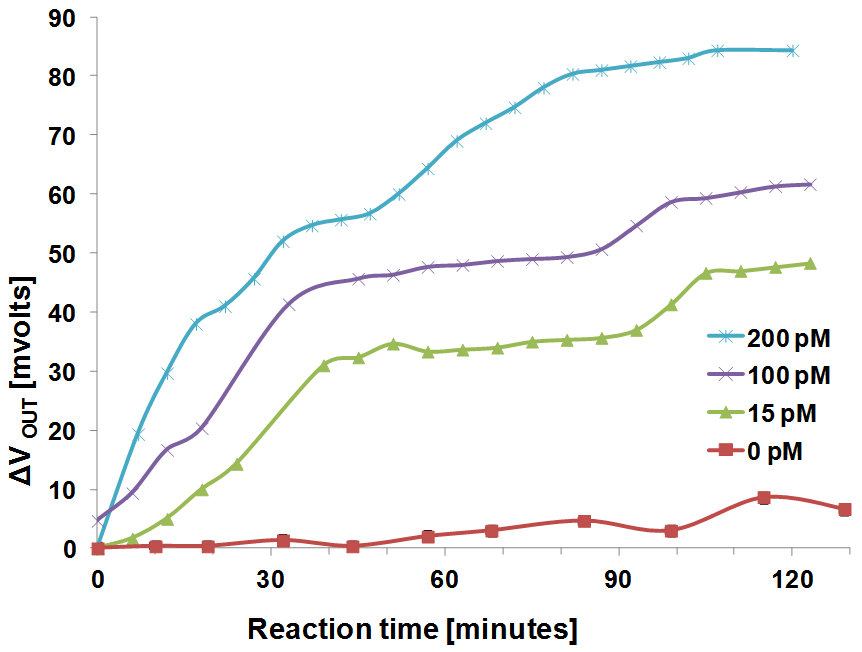Neuro-transistors and Biosensors
A. A Wireless System Monitoring both Electrophysiological and Neurochemical Activities in the Brain for Investigating the Mechanism and Precise Neuromodulation Therapy
Introduction :Drug addiction leads to malfunction of neural network connectivity, as well as unbalanced releasing of different neurotransmitters, in different brain areas. Understanding when and where the brain activity is influenced during different stages of drug addiction is crucial for developing novel treatments for drug addiction. Methamphetamine (METH) is known to induce complex changes in the rewarding circuit of the brain, including unbalanced neurotransmitter release, such as dopamine (DA) and glutamate (Glu), and abnormal neural activity within the prefrontal cortex (PFC) and nucleus accumbens (NAc). To understand how METH addiction alters brain circuits in different stages, so as to identify precise neuromodulation strategy for treating METH addiction, this project aims to develop a wireless, lightweight system able to monitor both electrophysiological activity and neurotransmitter release in multiple brain regions simultaneously. The system will be employed to study the brain circuits of conditioned place preference (CPP) rat models. The study will focus on the PFC and NAc, and both DA and Glu concentrations will be monitored at sub-second resolution. The understanding of how METH addiction alters these brain activities will then underpin the development of precise neuromodulation strategies for suppressing METH addiction, especially for the reinstatement stage. The precision here refers to triggering brain stimulation at precise timing, as well as adapting stimulation patterns in real-time. Finally, different strategies will be verified with the CPP model in this project. This project will mainly conduct by researchers from both the National Tsing Hua University and the National Health Research Institute, who have expertise in the design of biomedical chips, integrated optics, neural electrophysiology, and preclinical studies on drug addiction, respectively. The project is anticipated to deliver a wireless, multi-modal system for preclinical study on novel neuromodulation schemes, as well as to identify precise neuromodulation strategies for treating METH addiction. Both the technology and the findings of the preclinical study will underpin the development of novel bio-electronic medicine for clinical application.
Characteristics : The electrical models of electrode-electrolyte interfaces will be identified first to facilitate the design of neuron-electronic interfaces and corresponding circuits. The technology for integrating circuits with optical interfaces will be developed to enable multisite fiber photometry. Finally, a multi-modality microsystem will be developed for in-vivo animal experiments
Pre-requisites:Knowledge in VLSI design, basic integrated optics, and basic neuroscience
Professional skills obtained:Knowledge in neuro-electrophysiology, Experience in integration of electronic circuits with optical devices, silicon optics technologies, Methodology in modeling and designing bio-electronic interfaces, mixed-mode ICs.
B. Neurotransistors
Introduction :The advances in neuroscience have lead the development of neural prostheses such as artificial retina and brain-machine interfaces for neural rehabilitation. However, there remains little knowledge on how neurons interact with each other to form neuronal networks and their high-level (cognitive) functions. The main obstacle is the lack of a platform able to interact with neuronal networks in real-time, allowing the synaptic changes induced by the interactions to be studied. This project aims to develop a microsystem-on-a-chip integrating neuro-transistors with microfluidics (Fig.1) for studying how neuronal networks respond to external stimulation and adapt inter-neuron connections. The neuro-transistor is fabricated by removing the gate of transistors in the standard CMOS technology. In addition to studying neuronal networks, the microsystem can be applied to drug discovery、cell-based sensors、diseases inspection、etc. (Fig.2). The integrated circuitry is also applicable to brain-machine interfaces.
Characteristics : The electrical models of neurons and neuron-electronic interfaces will be identified first to facilitate the design of neuron-electronic interfaces and corresponding circuits. After the integrated circuits and interfaces are fabricated by standard CMOS processes, post-CMOS MEMS technique will be applied to fabricate neuro-transistors and the microfluidics that guide the growth of neurons.
Pre-requisites:Knowledge in semiconductor process, VLSI design, and basic neuroscience
Professional skills obtained:Knowledge in neuro-electrophysiology, Experience in CMOS MEMS design, Microfluidics technologies, Methodology in modeling and designing bio-electronic interfaces, mixed-mode IC design.

Fig.1 :The microsystem integrating neuro-transistors with microfluidics and neuro-electronic interface circuits.

Fig.2 :(a)The neural circuit of crayfish for testing the neuro-transistors called OSFET (b)CMOS-compatible OSFET arrays (both MOS and LBJT) with functional circuits (c)SEM photo of the OSFET. (d) The LBJT mode is proved to reduce the noise of OSFETs by more than two orders. (e)Neural activity of crayfish recorded by the OSFET, and (f)DNA detection with the OSFET.
C. Biosensors
Introduction :The ability to detect DNAs or Proteins with high specificity and sensitivity is crucial for early diagnosis and therapy of many diseases. To monitor bio-molecules and their interactions in real time, fluorescent imaging and electrophoresis are unfavorable because labeling and imaging processes normally impede real-time detection. Instead, most label-free technologies are based on electrical detection of the intrinsic charges of bio-molecules, or the impedance changes of an electrode-electrolyte interface due to the absorption or binding of bio-molecules. This project exploits standard CMOS technologies to develop micro-sensor arrays with integrated circuitry for label-free detection of bio-molecules, as well as for label-free, real-time monitoring of bio-molecule reactions. The biosensors we have developed include ISFETs basing on neuro-transistors, Extended-gate FETs compatible with the standard CMOS tech., and Gold electrodes of the BioMEMS technology supported by the CIC in Taiwan.
Characteristics : The signal changes induced by target bio-molecules are first characterized and modelled. The geometry and the structure of the biosensors are then designed to ensure enough sensitivity. The integrated circuitry for reading out the signal changes automatically is also designed and integrated with the biosensors on a single chip.
Pre-requisites:Knowledge in electronics, VLSI design, and basic electrochemistry.
Professional skills obtained:Knowledge in electrochemistry, Experience in CMOS MEMS design, Methodology in modeling and designing bio-electronic interfaces, mixed-mode IC design.

(a)

(b)
Fig.3 :(a)The experimental setup and photo of the EGFET for detecting PDGF by immobilized DNA amplification in real time. (b) The measured responses of EGFETs to the synthesis of DNAs immobilized on the sensor surface. The DNA amplification was triggered by different concentrations of PDGF (0, 15, 100, 200 pM)






